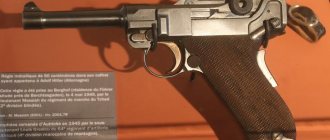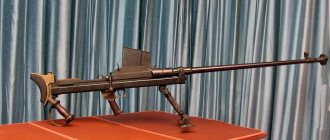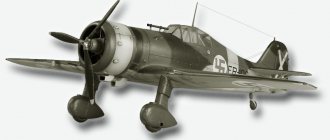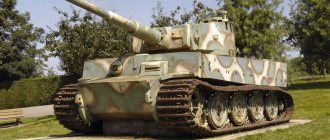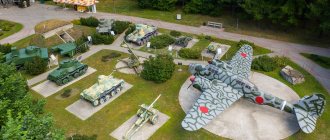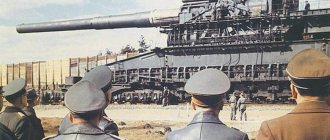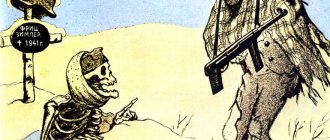During the Second World War, machine guns became the main destructive force of small arms at medium and long combat ranges: among some shooters, self-loading rifles were gradually replaced by submachine guns instead of self-loading rifles. And if in July 1941 the rifle company had 6 light machine guns, then a year later - 12, and in July 1943 - 18 light machine guns and one heavy machine gun.
Weapon of Victory. Small arms of the Red Army
The creator of PPSh, Georgy Semyonovich Shpagin, was born in 1897 into a peasant family in the village of Klyushnikovo. From 1916 to 1920, he served as a gunsmith in an infantry regiment, and after demobilization he entered the experimental workshop of the design bureau of the Kovrov Machine Gun Plant as a mechanic.
This step determined the direction of his future activities, since he was lucky to work under the supervision of the famous weapons designer Vasily Alekseevich Degtyarev.
Subsequently, Shpagin participated in work on machine guns and developed a ball mount for mounting a 6.5-mm coaxial light machine gun of the Fedorov-Shpagin system in a tank
, improved existing machine guns and, among other things, designed a belt feed mechanism for the large-caliber 12.7-mm Degtyarev machine gun with cartridges supplied from a disk magazine, which was then renamed “DShK model 1938” (Degtyarev - Shpagin). Along with this, he was designing a submachine gun.
Designer of the Soviet PPSh-41 submachine gun Georgy Semenovich Shpagin (1897–1952)
In the Soviet Union, the development of submachine guns began in the mid-1920s, but due to the conservative views of the generals, it proceeded rather sluggishly. Already at the beginning of 1939, after the production of less than 5,000 copies, the production of Degtyarev PPD submachine guns of the 1934 model, which began in 1935, was stopped and all already manufactured weapons were put into warehouses. In order for the generals to recognize the need for such weapons, the experience of the Soviet-Finnish Winter War was required, and in 1940 it was decided to begin production of improved models of the Degtyarev PPD mod. 1934/38 and PPD arr. 1940
PPD submachine guns were very popular among the troops, primarily due to the large supply of cartridges in the drum magazine, which could hold 71 rounds. But, despite numerous design changes, Degtyarev submachine guns required large material resources and time during production, and production could not cover the ever-increasing demand.
Although the PPD models were reliable and also very popular among the troops, they were complex and also expensive to produce.
On August 26, 1940, Shpagin’s hour struck - he was able to present to the Artkom GAU (Artillery Committee of the Main Artillery Directorate) a prototype of his submachine gun developed at that time. In his design, he summarized the experience of the war with Finland and deliberately paid attention to making it as simple as possible.
After numerous tests of prototype weapons, in November 1940, extensive comparative firing of the newly developed weapons took place: 25 Shpagin submachine guns against 15 Boris Gavrilovich Shpitalny submachine guns, as well as for comparison several Degtyarev models already adopted for service.
Despite the fact that Shpitalny’s weapon was able to show lower dispersion and a higher initial bullet velocity, Shpagin’s weapon was captivating due to its simple handling, lighter weight of 3.5 kg and technological advantages in manufacturing. Probably, the last of the above was then of decisive importance, since the production time of the Shpagin submachine gun - 5.5 hours - was only half of the time spent on the production of one PPD-40 submachine gun.
On December 21, 1940, Shpagin’s development was adopted by the Red Army as a new standard submachine gun under the official designation “7.62 mm Shpagin submachine gun mod. 1941."
PPSh-41 early release with a sector sight with a range from 50 to 500 m and an unprotected front sight. Later versions of the PPSh-41 had a flip-up sight at ranges of 100 and 200 m
The small town of Zagorsk, located only a few hours away from Moscow by car, was chosen as the location for production. There, in October 1941, that is, just a few months after the German invasion, mass production began. Soon there was a danger that the city could be captured in the foreseeable future, and an urgent evacuation of the enterprise to the village of Vyatskie Polyany followed.
The technologically advanced PPSh-41 submachine gun quickly began to be produced in large quantities and, thus, despite the evacuation of production shops, over 92 thousand units were delivered by the end of 1941 alone. The following year, production increased to almost 1.5 million, and by the end of the war the total number of copies produced reached 5 million.
Production of PPSh-41 submachine guns in Vyatskie Polyany during the war
The submachine gun operates due to the recoil of the free bolt, which is located on the sear in the rear position before the shot, the rollback of which is slowed down by a buffer. The replacement firing pin is rigidly fixed and its firing pin protrudes outward from the bolt mirror. The shooting mode can be selected using a slider located directly in front of the trigger. If it is moved back, a single-shot mode is provided; if you move it forward, you can fire in a continuous burst. The weapon feels good in the hands, despite the high rate of fire of almost 1000 rounds per minute. The front, beveled part of the barrel casing serves as a compensator. The trigger mechanism has no warning. A simple slide at the top of the cocking handle serves as a safety feature, both in the cocked state and in the forward position of the bolt.
The submachine gun can be fed from a drum magazine that holds 71 rounds, or from a later developed box magazine that holds 35 rounds. Although drum magazines were popular due to their capacity, they had the disadvantage that they were rather slow to reload in battle. By the way, they were not interchangeable with the PPD-40 magazines.
Soviet PPSh-41 submachine gun in 7.62×25 caliber with an attached 71-round drum magazine and an underlying box magazine holding 35 rounds
Aiming was carried out through a reversible sight at 100 and 200 m, and for early production submachine guns - through a sector sight with settings from 50 to 500 m. During production, various design improvements were made: the initially uncovered front sight began to be provided with a riveted fuse made of strip sheet steel, the barrel began to be chrome-plated, and the bolt buffer was made of less expensive material. Cleaning accessories were placed in the cavity of the PPSh-41 butt.
The butt contains: a dismountable cleaning rod, a screwdriver and a cleaning cord. Oiler with two compartments carried in a pouch
Disassembly is very simple: you need to press the latch located at the rear end of the receiver, and, pressing the casing above the muzzle of the barrel, turn the receiver. Then pull the bolt back a little and pull it up along with the recoil spring and buffer.
Complete disassembly of the PPSh-41 submachine gun with a drum magazine. The production of one type of weapon required only 5.5 hours
However, the simple design also had hidden disadvantages: the most significant of them was insufficiently reliable protection. Drum magazines also often could not bear the load. The operation of the internal mechanism could easily be blocked by dents.
The only safety mechanism consists of a slider on the cocking handle.
Unlike the Western warring powers, in the Soviet Union submachine guns became the main weapon of the infantry - a circumstance that the Wehrmacht painfully felt for itself. The German MP40 submachine gun could have been exactly the same, but with its 32-round magazine, at decisive moments it was still inferior to the PPSh-41, equipped with a 71-round drum magazine.
Group photo with submachine guns PPSh-41 and PPS −3
In addition, a large number of Red Army soldiers were armed with submachine guns. Accordingly, captured PPSh-41s, which were designated MP 717® in the Wehrmacht, were popular and very rarely transferred to collection sites for captured property. There were even attempts to convert the PPSh-41 submachine gun to chamber a 9x19 caliber cartridge. This required a new barrel and a pressed sheet steel adapter for the magazine receiving window to be able to attach the MP40 box magazine.
Most PPSh-41s of a later production period are equipped with a reversible sight, as well as a protected front sight
In February 1942, Shpagin presented to the Artillery Committee a version of his submachine gun, specially modified for tank crews and paratroopers, in which the wooden stock could now be detached. But the advantage was negated by unreliable fastening and increased weight. The weapon was rejected. Another alteration was needed.
Shpagin presented the result already in May of the same year: the PPSh-42 submachine gun. Its main feature is a rectangular receiver stamped from steel sheet, complemented by a detachable wooden butt or a metal folding shoulder rest. The simplified trigger mechanism allowed only continuous firing; otherwise, the internal structure of the weapon did not differ from the PPSh-41 submachine gun.
The safety consists of a long dust cover located on the side with cutouts for the cocking handle. If the lid covers the groove of the box, then it blocks the cocking handle in one of the cutouts depending on its position. Despite the fact that the PPSh-42 submachine gun made a good impression during tests conducted from May 30 to June 2, it only took second place. The design of Alexey Ivanovich Sudaev won. His PPS-42 submachine gun was also easy to manufacture and had less dispersion when firing. For greater confidence, military tests of a small series of 250 PPSh-42 units were also carried out, but the decision did not change.
Shpagin's improved model arr. 1942 was manufactured for military trials in quantities of only 250 pieces
As an experiment, the PPSh-41 submachine gun was even used as an on-board weapon on an aircraft: in 1944, the Tupolev Design Bureau experimented with installing submachine guns for firing at ground targets. Therefore, several Tu-2Sh type bombers received a platform with 88 submachine guns installed in the bomb bay. The submachine guns were pointed downwards at an angle of 45˚, each was equipped with a conventional drum magazine for cartridges and could only fire at the same time. But it turned out that the ammunition capacity of the drums (71 rounds each) was too small, and reloading in flight was impractical, so the project was closed.
A battery of 88 PPSh-41 submachine guns on a lowered platform in the bomb bay of a Tu-2
After the end of the war, Shpagin experimented with curved barrels to better protect the tank from attacking infantry. Shpagin also bent the barrel along with the casing by 30˚. Otherwise, the design of the weapon remained unchanged and nothing is even known about a special sight. However, the tests were clearly unsatisfactory: the greatly reduced muzzle velocity and large dispersion at ranges of up to 50 m led to the cessation of work.
Activities of G.S. Shpagina was highly appreciated. For the submachine gun and various other developments, such as the signal pistol, he was awarded numerous high awards: the title of Hero of Socialist Labor, the Stalin Prize of the second degree, three Orders of Lenin, the Order of Suvorov of the second degree and the Order of the Red Banner.
After the war, due to serious health problems G.S. Shpagin parted ways with his professional activities, but he spent the rest of his life in the city of Vyatskie Polyany. There, on February 6, 1952, he died at the age of 56. Today he rests at the Novodevichy cemetery in Moscow.
The production of the PPSh-41 submachine guns in Russia ended soon after the war, and in December 1959, a new generation of weapons began to roll off the assembly line in Vyatskie Polyany - the Mikhail Timofeevich Kalashnikov RPK machine gun.
In other countries of the socialist camp, copies of the PPSh-41 remained in production for a long time. In 1950, China began its own production of a copy called the Modell 50, Poland began production in 1952, and North Korea only in 1955.
In Yugoslavia, the design underwent extensive processing, so that the weapon manufactured at the Zavodi Crvena Zastava plant in the city of Kragujevac in the form of the Modell 49 sample had only an external similarity with its prototype. For example, the receiver was no longer hinged; now for disassembly it was necessary to unscrew the cover from the back. The characteristic barrel casing became cylindrical and had many small holes for cooling. However, box magazines remained interchangeable.
Zastava M49 submachine gun
In a slightly modified form with milled parts, the PPSh-41 was copied by the Croats and was produced as a 9x19 caliber Šokac submachine gun from 1991 onwards during the Yugoslav War.
Machine guns in the general weapon system of the Red Army during the Great Patriotic War
During World War II, the share of machine guns in infantry armament changed. The reduction in the production of self-loading rifles, as well as the small effective firing range of submachine guns, became the reason for the increase in the importance of machine guns in combat at medium (up to 1 thousand m) and long (up to 2 thousand m) ranges. The rifle company in July 1941 had six light machine guns on staff, in July 1942 - 12 light machine guns (while the German company had 12 single or light machine guns), in July 1943 - one heavy and 18 light machine guns, in December 1944 – 2 heavy and 12 light machine guns. That is, during the war the number of machine guns more than doubled. The decrease in the share of light machine guns towards the end of the war is associated with an increase in the number of mortars and submachine guns. By the end of the war, the rifle regiment had 108 light and 54 heavy machine guns for 2,398 people (for comparison, a German infantry regiment for 2,000 people had 107 light and 24 heavy machine guns).
"Tachanka" 1943 - machine gun "Maxim" mod. 1941 in a Willys car
The total number of machine guns produced during the Second World War: - II half of 1941 - 106,200 units. (during the evacuation of the Tula arms factory); - I half of 1942 - 134,100 units. (at plant No. 526 (Stalinsk) DPs were produced, at plant No. 524 (Izhevsk) - "Maxim", at plant No. 54 (Zlatoust) - "Maxim", at the Tula Machine-Building Plant during this period the production of "Maximov" was resumed, in DShK production was carried out in Kuibyshev); - II half of 1942 - 222,000 units; - I half of 1943 - 236,000 units; - II half of 1943 - 222,500 units. (at plant No. 2 (Kovrov) production of SG-43 was established); — I half of 1944 – 230,500 units. (at plant No. 54 (Zlatoust) they also launched production of SG-43); — II half of 1944 — 208,600 units; — I half of 1945 – 117,500 units.
During the war, the following number of machine guns was supplied to the armed forces of the USSR (including weapons from pre-war stocks, as well as supplies under Lend-Lease): II half of 1941 - 45,300 manual, 8,400 easel, 1,400 large-caliber; 1942 - 172,800 manual, 58,000 easel, 7,400 large-caliber; 1943 - 250,200 manual, 90,500 easel, 14,400 large-caliber; 1944 - 179,700 manual, 89,900 easel, 14,800 large-caliber; I half of 1945 - 14,500 manual, 10,800 easel, 7,300 large-caliber.
If we take the number of weapons in the Red Army on January 1, 1942 as 100%, then on January 1, 1943 the number of submachine guns and rifles will be 180%, and on January 1, 1944 - 280%, machine guns - 210% and 450%, respectively. In defense, the average density of rifle and machine-gun fire increased from 1.2-1.6 bullets per minute per linear meter in the first period of the war to 9-12 bullets per minute in the third period. At the same time, the depth of continuous small arms fire decreased to 200 meters, since the main contribution was made by submachine guns.
During the Second World War, the Active Army of the Soviet Union consisted of: 06/22/1941 - 170,400 light machine guns, 76,300 easel machine guns, 2,200 large-caliber; 01/01/1942 - 81,000 light machine guns, 30,000 heavy machine guns, 2,200 large-caliber; 01/01/1943 - 177,100 light machine guns, 63,500 easel, 4,700 large-caliber; 01/01/1944 - 344,500 light machine guns, 133,000 heavy machine guns, 18,200 large-caliber; 01/01/1945 - 418,100 light machine guns, 184,700 heavy machine guns, 31,100 large-caliber; 05/09/1945 - 405,400 light machine guns, 182,600 heavy machine guns, 37,500 heavy-caliber.
Throughout the war, the importance of machine gun fire remained in the country's military air defense and air defense. Of the 3,837 aircraft that were shot down by front-line troops in the period from June 22, 1941 to June 22, 1942, 295 were shot down by anti-aircraft machine guns, 268 by rifle and machine gun fire from troops. In the air defense of Moscow on June 22, 1941 there were 105 anti-aircraft machine guns, on January 1, 42 - 511, on October 1, 44 - 686. The number of machine guns in the country's air defense during the war increased 12.1 times, as a rule they were large-caliber machine guns. Their role in the country's air defense decreased by the end of the war, but increased significantly at the front. Despite the fact that the use of heavy machine guns when setting up barrage fire was beneficial, it could not completely replace special anti-aircraft installations. Large-caliber machine guns were much more effective than normal-caliber machine guns, however, even here, machines with free aiming were inferior to installations with a mechanical or electromechanical pointing drive and more advanced sights.
Soviet heavy machine gun DShK (Degtyareva - Shpagina large-caliber)
Change in personnel and the saturation of the Red Army rifle division with automatic weapons (by state): Personnel: as of April 1941 - 14,483 people; July 1941 – 10859 people; December 1941 – 11626 people; December 1942 – 9435 people; December 1944 – 11,706 people; June 1945 – 11,780 people; The total number of submachine guns in the same periods was: 1204 pcs. (or 83 pieces per 1000 people); 171 (15.75 per 1000); 582 (50 per 1000); 727 (77 per 1000); 3594 (307 per 1000); 3557 (302 per 1000); The total number of light machine guns in the same periods was: 392 pcs. (or 27 per 1000 people); 162 (15 per 1000); 251 (21.5 per 1000); 494 (52.4 per 1000); 337 (28.8 per 1000); 383 (32.5 per 1000); The total number of heavy machine guns in the same periods was: 166 pcs. (or 11.5 per 1000 people); 108 (10 per 1000); 109 (9.4 per 1000); 111 (11.76 per 1000); 166 (14.2 per 1000); 178 (15.1 per 1000); Number of shots from small arms and machine guns per minute; April 1941 – 297460; July 1941 – 140470; December 1941 – 190930; December 1942 – 204710; December 1944 – 491160; June 1945 – 492720.
During different periods of the war, there was a change in the weapons system not only of the USSR but also of Germany:
In December 1941, the personnel of the German infantry division numbered 14,742 people. (USSR Rifle Division - 11,626 people) were armed with 705 submachine guns (528 in the USSR), 454 light machine guns (251 in the USSR), 112 heavy machine guns (109 in the USSR). In addition, the German infantry division did not have anti-aircraft machine gun installations, while the USSR rifle division was armed with 33 anti-aircraft machine gun installations, including large-caliber ones.
At the beginning of 1943, the personnel of the German infantry division numbered 13,656 people. (USSR rifle division - 9435 people) were armed with 681 submachine guns (727 in the USSR). At this time, the German troops did not have light or heavy machine guns, and the rifle division was armed with 494 light and 111 heavy machine guns. With regard to anti-aircraft machine gun installations, the situation changed - the infantry division had 18 20-mm anti-aircraft machine gun installations, but the rifle division did not have this type of weapon. It should be noted that at the beginning of 1943, the Guards Rifle Division (10,670 personnel) had 166 heavy and 499 light machine guns and 1,097 submachine guns; separate rifle brigade (4197 people) - 36 heavy and 109 light machine guns, motorized rifle brigade (4000 people) - 36 heavy and 98 light machine guns.
DP light machine gun. Great Patriotic War 1941-1945 Degtyarevsky DPs took third place in terms of mass production - after the Mosin rifle-system and the PPSh-41 submachine gun designed by G.S. Shpagin
In December 1944, the personnel of the German infantry division numbered 12,801 people. (USSR rifle division - 11,706 people) were armed with 1,595 submachine guns and assault rifles (3,594 in the USSR), 614 light machine guns (337 in the USSR), 102 heavy machine guns (166 in the USSR). During this period, the rifle division was armed with 18 12.7-mm anti-aircraft machine gun installations.
Before World War II, the idea that a mass-produced self-loading rifle could take on some of the tasks solved with light machine guns was partly revived. However, practice has shown that the use of light machine guns removes the relevance of high-power “automatic” rifles. The experience of the war became the reason for the revision of the ranges of use of small arms downward due to the increased density of artillery and mortar fire, the widespread use of attack aircraft and tanks. The 1942 “Combat Manual of the Infantry” (BUP-42) established that the fire of heavy machine guns is valid at a range of up to 1000 meters, “however, it is better to conduct sudden fire at distances of 600 meters or less” (“close” ranges), light machine guns - up to 800 meters. Light machine guns fired at air targets at ranges of less than 500 meters, mounted machine guns with an anti-aircraft sight - less than 1000 meters, and with a conventional sight - less than 500 meters. For comparison: before the war, the firing range of light machine guns was set in the range from 800 to 1200 meters, heavy machine guns for ground targets - 3000-5000 meters, for air targets - up to 1500 m. However, the increase in the saturation of artillery did not reduce the importance of machine guns.
After the division of the battle formation into pinning and shock groups was cancelled, the light machine gun always began to operate in the squad chain. During an offensive, the machine gun was usually the first to move to a new position (fire could be carried out on the move), and when leaving the battle, it was the last. A light machine gunner as part of a tank landing suppressed anti-tank weapons and covered the actions of the riflemen. Tanks for heavy machine guns often played the role of “machine gun carriers”.
Service and operational requirements were also changed. At the beginning of 1942, competitions were announced for lightweight models of heavy and light machine guns, and a submachine gun. The work was carried out in two directions: the modernization of the Degtyarev infantry machine gun and the development of a new light machine gun, which could be serviced and carried along with the ammunition by one soldier.
The heavy machine gun at that time was the main group fire weapon of rifle (infantry) units, capable of conducting intense fire with a combat rate of fire of 250-300 rounds per minute. Machine gun companies, equipped with heavy machine guns, were usually assigned to rifle companies by platoon. According to BUP-42, heavy machine guns distributed in depth and along the front covered the advance of the unit, supported the attack, hit enemy heavy weapons crews, ensured advance in depth and flanks, and repelled a counterattack. Indirect fire was practically not used, as was shooting over the heads. As a rule, heavy machine guns fired from behind the flanks and into gaps.
Crew of sailors at an anti-aircraft machine gun
Shooting at long ranges was still carried out, for example, at crossings or in the mountains, but even in these cases the range did not exceed 3000 meters. Reducing the ranges made it possible, firstly, to reduce the range of cartridges used (cartridges with a heavy bullet were excluded), and secondly, to again raise the issue of creating a lightweight heavy machine gun. However, the dimensions of the heavy machine gun, the time spent on changing positions and preparing to fire, did not allow these machine guns to be advanced to the front lines, since they could be late in reacting to the revived enemy firing points or his counterattack. In populated areas, forests and mountains, the bulkiness of machine guns was especially sensitive.
Heavy machine guns showed their capabilities and power in defense. At the same time, the position was adapted for shooting at various ranges and to the requirements of all-round defense. Machine gun fire at strong points provided flanks and gaps, covered the positions of artillery and anti-tank crews, they were moved to forward positions and points, and separate duty and “dagger” machine guns were allocated. It was practiced to create areas of barrage and concentrated fire from heavy machine guns, which were superimposed on areas of artillery and mortar fire.
Fire structures for machine guns were further developed. For example, during the Battle of Stalingrad, 200 bunkers were created in the city, and 37 armored and reinforced concrete caps for machine guns were installed. More attention was paid to firing in the dark, training crews to zero in on landmarks and lines, as well as techniques for recording aiming with artificial dispersion in depth and along the front. Quick maneuvers with heavy machine guns, the importance of which is especially important during defense on a wide front, were difficult even after the transition to a trench system with full-profile trenches.
The transition to a new weapons system began in the middle of the war. The appearance of a lightweight light machine gun became possible after the intermediate power cartridge was created, but production of the RPD began only in the last months of World War II. But among the new models, the SG-43 heavy machine guns were adopted by the Red Army. The quick and successful implementation of the experimental design reserves and combat experience accumulated before the war in new weapons testified to the creation of an effective system of design, testing and production.
The predilection of the Red Army commanders for a wheeled machine gun machine is explained by the fact that such a machine made it possible to move a machine gun ready to fire (most machine guns on tripod machines had to be removed from the machines and reinstalled in a new position), however, in general, such a machine rather constrained the actions of the crew . Combat experience has shown the advantages of a tripod machine with the ability to conduct anti-aircraft fire over universal and wheeled machines.
Despite the fact that large-caliber machine guns, according to the Manual on Small Arms, were intended “for firing at air targets” and also “for combating enemy firing points and manpower covered by light armor,” their main task was the role of anti-aircraft. As a rule, firing at air targets was carried out at ranges of less than 1.5 thousand meters. Anti-aircraft machine guns were usually located no further than 300-500 meters from the front edge of the defense. With the help of these machine guns, control points, front-line roads and railways were covered. For example, in May 1943, 558 heavy machine guns were used to protect the railway communications of the fronts. During the war years, anti-aircraft machine guns (quadruple Maxims and DShK) shot down 2,401 enemy aircraft. Firing at low-flying high-speed targets increased the requirements for combat rate of fire and the possibility of use on complex installations (this was embodied in the modernization of the DShK).
But the possibility of flat long-range shooting, the penetrating effect of bullets (for battles in the city or mountains), and the growing share of light armored vehicles were not ignored - for example, the DShK had to be used in anti-tank defense during the Battle of Kursk.
During the war, the need for more powerful machine guns became apparent. To solve this problem, the USSR returned to machine guns chambered for a 14.5 mm cartridge. Some countries preferred to use automatic small-caliber guns. At the final stage of the war, supplies of the DShK heavy machine gun to the troops did not decrease, unlike heavy and light machine guns.
During the war, search work did not stop. For example, in 1942-1943, the need to lighten light machine guns became the reason for the creation of BC by Deikin, N.M. Afanasyev and V.F. Lyuty at the Small Arms Scientific Testing Ground for a belt-fed LAD machine gun chambered for a 7.62-mm TT pistol cartridge. The deterioration of shooting accuracy was one of the main reasons for the general desire to increase the density of fire. It is not surprising that “heavy fire” installations appeared, such as the experienced 8-barreled machine gun I.I. Slostina.
Based on materials from the article by Semyon Fedoseev “Machine guns of the Second World War”
Machine guns of the USSR army during the Second World War
The Red Army began World War II with two types of machine guns. The first is the well-known “Degtyarev Infantry”, designated DP. This weapon has a disc magazine with a capacity of 47 rounds. The cartridge supply system turned out to be quite good. Rim-cased cartridges often caused delays in firing guns with box magazines. A large flat single-row disk magazine with a spring feeder eliminated double feeding of the cartridge. The magazine originally had a capacity of 49 rounds, then it was reduced to 47 to reduce the likelihood of misalignment.
Degtyarev light machine gun (DP-27)
In 1944, a modernized version appeared - a DPM with a replaceable barrel, which could be removed using a special screwdriver. The recoil spring was placed in a tube under the barrel to reduce the chance of it overheating, which had previously caused it to weaken.
DPM machine gun
Tank modifications of the DP and DPM machine guns received the designations DT and DTM, respectively. Despite their age, DP and DPM machine guns can still be found in some areas of the world.
DTM tank machine gun
The second machine gun that was used during the Second World War, which had proven itself since the First World War, was the Maxim, model 1910/30, modified for a heavier bullet weighing 11.8 g. Compared to the 1910 model, its design about 200 changes were made. The machine gun has become lighter by more than 5 kg, and the reliability of the automation has increased. It was located on Sokolov's wheeled machine.
Machine gun "Maxim" model 1910
The specifics were the use of fabric tape and water cooling of the barrel. The machine gun itself weighed 20.3 kg (without water); and together with the machine – 64.3 kg. The Maxim machine gun was a powerful and familiar weapon, but at the same time it was too heavy for maneuverable combat, and water cooling could cause difficulties when overheating: fiddling with canisters during combat is not always convenient. In addition, the Maxim device was quite complex, which was important in wartime.
The question of replacing the Maxims with a more modern design remained, and in October 1943, 7.62-mm heavy machine guns of the Goryunov system of the 1943 model (SG-43) began to enter the troops. It is interesting that Degtyarev honestly admitted that the SG-43 is better and more economical than his design - a clear demonstration of the difference between competition and competition.
Goryunov machine gun (SG-43)
The Goryunov heavy machine gun turned out to be simple, reliable and quite light, but production was launched at several enterprises at once, so that by the end of 1944, 74 thousand units were produced.



